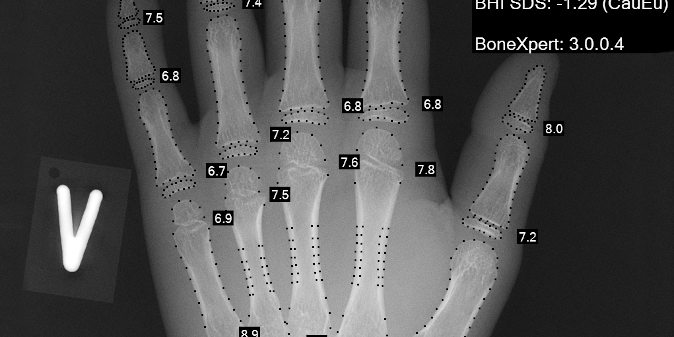
Companies: Visiana, VUNO Products: BoneXpert, VUNO Med-BoneAge
A comparison of two artificial intelligence-based methods for assessing bone age in Turkish children: BoneXpert and VUNO Med-Bone Age
Diagnostic and Interventional Radiology, 2024
Abstract
Purpose
This study aimed to evaluate the validity of two artificial intelligence (AI)-based bone age assessment programs, BoneXpert and VUNO Med-Bone Age (VUNO), compared with manual assessments using the Greulich-Pyle method in Turkish children.
Methods
This study included a cohort of 292 pediatric cases, ranging in age from 1 to 15 years with an equal gender and number distribution in each age group. Two radiologists, who were unaware of the bone age determined by AI, independently evaluated the bone age. The statistical study involved using the intraclass correlation coefficient (ICC) to measure the level of agreement between the manual and AI-based assessments.
Results
The ICC coefficients for the agreement between the manual measurements of two radiologists indicate almost perfect agreement. When all cases, regardless of gender and age group, were analyzed, an almost perfect positive agreement was observed between the manual and software measurements. When bone age calculations were analyzed separately for boys and girls, no statistically significant differences were found between the two AI-based methods in any subgroup. For boys regardless of age, the ICCs were 0.995 for VUNO and 0.994 for BoneXpert (z = 1.597, P = 0.110), while for girls, the ICCs were 0.994 and 0.995, respectively (z = -1.303, P = 0.193). The overall agreement with manual measurements was high for both VUNO and BoneXpert. In both boys and girls, the agreement remained consistent across different age groups. These findings indicate that both AI-based bone age assessment tools have a high degree of agreement with manual measurements across all age and gender groups, with no significant superiority of one method over the other.
Conclusion
Both BoneXpert and VUNO demonstrated high validity in assessing bone age, with no statistically significant differences between the two methods across gender or pubertal status groups. Notably, this study represents the first evaluation of both BoneXpert and VUNO for bone age assessment in Turkish children, highlighting their potential as reliable and clinically relevant tools for this population.
Read full study